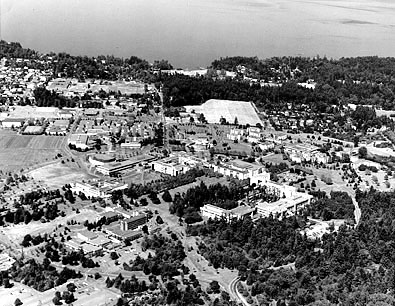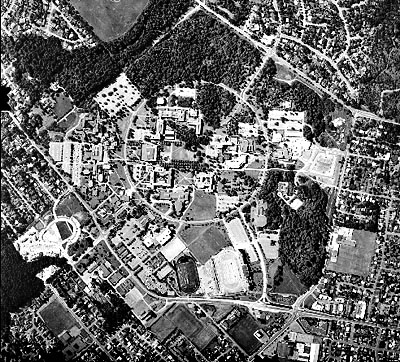





A Monument to
Modernism:
The University of Victoria and the Development of the Gordon Head Campus
The 125 acres of
Gordon Head military camp were acquired by Victoria College from the Federal
Government in 1959. Victoria College, not to become a university until
1963, was then located at the corner of Foul Bay and Lansdowne Roads,
now the location of Camosun College.
Victoria's then mayor, Richard Biggerstaff Wilson, also active in revitalizing
downtown Victoria, headed the fund drive. He and the College's consulting
architect, Robert Siddall, were instrumental in obtaining the services
of the San Francisco firm of architectural planners, Wurster, Bernardi
and Emmons. Siddall was to act locally for WBE in the planning exercise.
WBE brought in two San Francisco allies to work on the plan: Alfred W.
Baxter Jr., university planning consultants, and Lawrence Halprin & Associates,
landscape architects.
Emmons immediately devised the scheme for a 'garden campus'. The most
striking feature of the plan was a central campus surrounded by a ring
road. None of the academic units within the pedestrian-oriented ring would
be more than a ten minute walk away from the others. The academic buildings
would be grouped around a central quadrangle of open meadow. By 1988,
thanks to further land acquisitions, the campus had grown to 385 acres
(156 hectares).
In 1961, Muirhead and Justice were engaged as landscape consultants, and in 1963 John Lantzius (who had foremerly been with Muirhead and Justice as well as an apprentice at Halprin's) was brought on as "executive landscape consultant", still working under Halprin's overall guidance.
A 1968 document entitled Landscape Concept - University of Victoria articulates the guiding principles of the campus architecture:
It has been our intent from the beginning to reflect the native
plant material of Vancouver Island on the campus, and to create an imaginative
environment using such plants as Gary Oak, Arbutus, Dogwood and other
conifers. The major tree framework - which binds the buildings and open
areas into a unified composition - is the most important and must receive
the most emphasis. This tree framework of evergreen trees (broadleaf and
conifers) will be used primarily, in mass, to frame vistas, soften the
architectural elements, as backgrounds, and as extensions of the forest
areas.... The open areas will be contoured lawns which merge into the
native forest.

Emmons insisted that no building should attempt to dominate another, or its landscape setting. Structures, roads, and pathways should be landscaped in; the west coast flora should prevail.
In 1967, Erickson Massey Architect replaced WBE as UVic's prime consultant firm for a three year period. However, their extensive use of unrelieved slabs of grey concrete, dominant in the design of the Commons Block and residences, was not well received. In particular, Erickson's disregard of the Emmons Plan in his recommendation to surround the academic quadrangle with adjacent buildings was perceived as unacceptable. By 1972, WBE had been re-appointed and the firm was represented by Don Emmons until 1991, when the responsibility was passed to the Canon Design Group, Larry Canon having been in the office of WBE. Also, by this time, Don Vaughn & Associates (Vaughn formerly of Lantzius' office) had been appointed landscape consultants.
Two particular donations have reinforced the garden landscape of the University campus, which by 1975 had been transformed into verdant lawns and playing fields, bermed roads and pathways, treed boulevards and wooded glades. That year, the University received, by way of bequest, over 100 species of rhododendrons from the Lake Cowichan estate of Jeanne Simpson. These laid the foundations of the University Gardens at the main entrance to the campus at the juncture of Henderson and Ring Roads. And again in 1990, Lieut. Gov. Dr. David C. Lam donated funds to construct a major water feature, a fountain and reflecting pool in honour of retiring university president, Dr. Howard Petch. Don Vaughn was the designer.
Part of the orginal concept was to enliven the campus with public art. In addition to George Norris' monumental library panels and Di Castri's architectural sculpture, the campus features ceremonial poles by First Nations artists such as Henry and Tony Hunt, Floyd Joseph and Charles Elliott, as well as free standing bronze works by Victoria sculptor Elza Mayhew and benefactress Katharine Emma Maltwood. The University Art Collection, founded by Victoria College principal Harry Hickman, has grown to some 15,000 works, many of which enhance public spaces in campus buildings.

The Gordon Head Campus documents the development of modern architecture in Victoria over a period of some 40 years. As the scheme evolved, we can discern the strands of an early debate between the international rationalists with their admiration for the legacy of Le Corbusier, his doctrine of mechanistic architecture and the formal expression of materials for their own sake - (Don Siddall, John Wade, Don Wagg, Alan Hodgson, David Hambleton, Terry Williams) on the one hand, and on the other the romantic traditionalists in the manner of Prairie School practice: Frank Lloyd Wright and Bruce Goff who were more inspired by the site itself, local craft and design tradition, and the decorative possibilities of texture (John Di Castri, Barry Downs, Don Marshall, Allan Lester).
However, pure design principle was always compromised in favour of landscape aesthetics or the demands of individual departments and faculties. Local stone smoothed the transition through native groundcovers to exposed aggregate wall surfaces. Large multi-storey buildings were lifted above ground level then opened up on the main floor for public use or blend with the adjacent landscape. Large building complexes provide for pedestrian interpenetration by way of pergola breezeways, intimate court yards, glazed galleries or skylit concourses. And the habit of recessing or hooding windows creates shadow patterns on the wall surfaces much as the maturing arboreal leafy canopy treats the surface ground cover below. It remains to be seen if further additions to the built heritage at the Gordon Head Campus will continue to find this a useful design vocabulary.